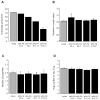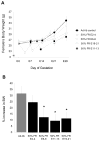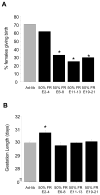Critical periods of susceptibility to short-term energy challenge during pregnancy: Impact on fertility and offspring development
- PMID: 19891981
- PMCID: PMC2795402
- DOI: 10.1016/j.physbeh.2009.10.017
Critical periods of susceptibility to short-term energy challenge during pregnancy: Impact on fertility and offspring development
Abstract
In female mammals, reproduction is tightly regulated by energy status and food availability. Although acute energetic challenges inhibit female reproductive behavior and gonadotropin secretion, less attention has been given to the effects of short-term energetic challenge on pregnancy and gestation. Furthermore, species differences in pregnancy physiology necessitate more detailed analyses of specific pregnancy models. Here, we studied musk shrews, which display induced ovulation and obligate delayed implantation, and whose reproductive physiology is tightly linked to metabolic status. We tested whether acute energetic challenges of varied degrees given at specific pregnancy stages (including before and after delayed implantation) have different effects on gestational outcome and offspring postnatal development. We found that 48 h of either 40% or 50% food restriction, which reduced body weight and strongly inhibited sexual behavior, had minimal effects on pregnancy success and litter dynamics when administered early in gestation (pre-implantation). However, <30% of females experiencing short-term food restriction later in gestation successfully gave birth (versus > or =70% of ad-libitum fed controls), and the pups of these food-restricted females exhibited a 30% slower postnatal growth trajectory. Interestingly, although pregnancy success and litter dynamics were unaffected by food restriction before implantation, gestation length was increased by metabolic challenges experienced at this time, indicating that energy status may regulate the timing of implantation. We conclude that 1) there are critical periods of pregnancy, particularly after implantation, when short-term, mild energetic challenges have significant impacts on fertility and offspring postnatal development, and 2) delayed implantation may have evolved, in part, as a buffering mechanism to prevent pregnancy failure during impaired energy balance in early gestation.
Figures







Similar articles
-
NTP technical report on the toxicity studies of Dibutyl Phthalate (CAS No. 84-74-2) Administered in Feed to F344/N Rats and B6C3F1 Mice.Toxic Rep Ser. 1995 Apr;30:1-G5. Toxic Rep Ser. 1995. PMID: 12209194
-
Maternal Programming of Body Weight in Syrian Hamsters.Integr Comp Biol. 2017 Dec 1;57(6):1245-1257. doi: 10.1093/icb/icx108. Integr Comp Biol. 2017. PMID: 28992103
-
Energy restriction initiated at different gestational ages has varying effects on maternal weight gain and pregnancy outcome in common marmoset monkeys (Callithrix jacchus).Br J Nutr. 2004 Nov;92(5):841-9. doi: 10.1079/bjn20041269. Br J Nutr. 2004. PMID: 15533274
-
Effects of Radiofrequency Electromagnetic Field (RF-EMF) exposure on pregnancy and birth outcomes: A systematic review of experimental studies on non-human mammals.Environ Int. 2023 Oct;180:108178. doi: 10.1016/j.envint.2023.108178. Epub 2023 Aug 30. Environ Int. 2023. PMID: 37729852
-
Within-litter variation in birth weight: impact of nutritional status in the sow.J Zhejiang Univ Sci B. 2015 Jun;16(6):417-35. doi: 10.1631/jzus.B1500010. J Zhejiang Univ Sci B. 2015. PMID: 26055904 Free PMC article. Review.
Cited by
-
Maternal effects on reproduction in the precocial European hare (Lepus europaeus).PLoS One. 2021 Feb 17;16(2):e0247174. doi: 10.1371/journal.pone.0247174. eCollection 2021. PLoS One. 2021. PMID: 33596263 Free PMC article.
-
Influences of Maternal Weight and Geographic Factors on Offspring Traits of the Edible Dormouse in the NE of the Iberian Peninsula.Life (Basel). 2023 May 21;13(5):1223. doi: 10.3390/life13051223. Life (Basel). 2023. PMID: 37240868 Free PMC article.
-
Sexually dimorphic testosterone secretion in prenatal and neonatal mice is independent of kisspeptin-Kiss1r and GnRH signaling.Endocrinology. 2012 Feb;153(2):782-93. doi: 10.1210/en.2011-1838. Epub 2011 Dec 27. Endocrinology. 2012. PMID: 22202164 Free PMC article.
-
Getting fat or getting help? How female mammals cope with energetic constraints on reproduction.Front Zool. 2017 Jun 12;14:29. doi: 10.1186/s12983-017-0214-0. eCollection 2017. Front Zool. 2017. PMID: 28616058 Free PMC article.
-
Reproductive resilience to food shortage in a small heterothermic primate.PLoS One. 2012;7(7):e41477. doi: 10.1371/journal.pone.0041477. Epub 2012 Jul 25. PLoS One. 2012. PMID: 22848507 Free PMC article.
References
-
- Schneider JE. Energy balance and reproduction. Physiol Behav. 2004;81(2):289–317. - PubMed
-
- Wade GN, Jones JE. Neuroendocrinology of nutritional infertility. Am J Physiol Regul Integr Comp Physiol. 2004;287(6):R1277–96. - PubMed
-
- Bronson FH. Effect of food manipulation on the GnRH-LH-estradiol axis of young female rats. Am J Physiol. 1988;254(4 Pt 2):R616–21. - PubMed
-
- Bronson FH. Puberty in female rats: relative effect of exercise and food restriction. Am J Physiol. 1987;252(1 Pt 2):R140–4. - PubMed
-
- Hamilton GD, Bronson FH. Food restriction and reproductive development in wild house mice. Biol Reprod. 1985;32(4):773–8. - PubMed
Publication types
MeSH terms
Grants and funding
LinkOut - more resources
Full Text Sources
Medical

